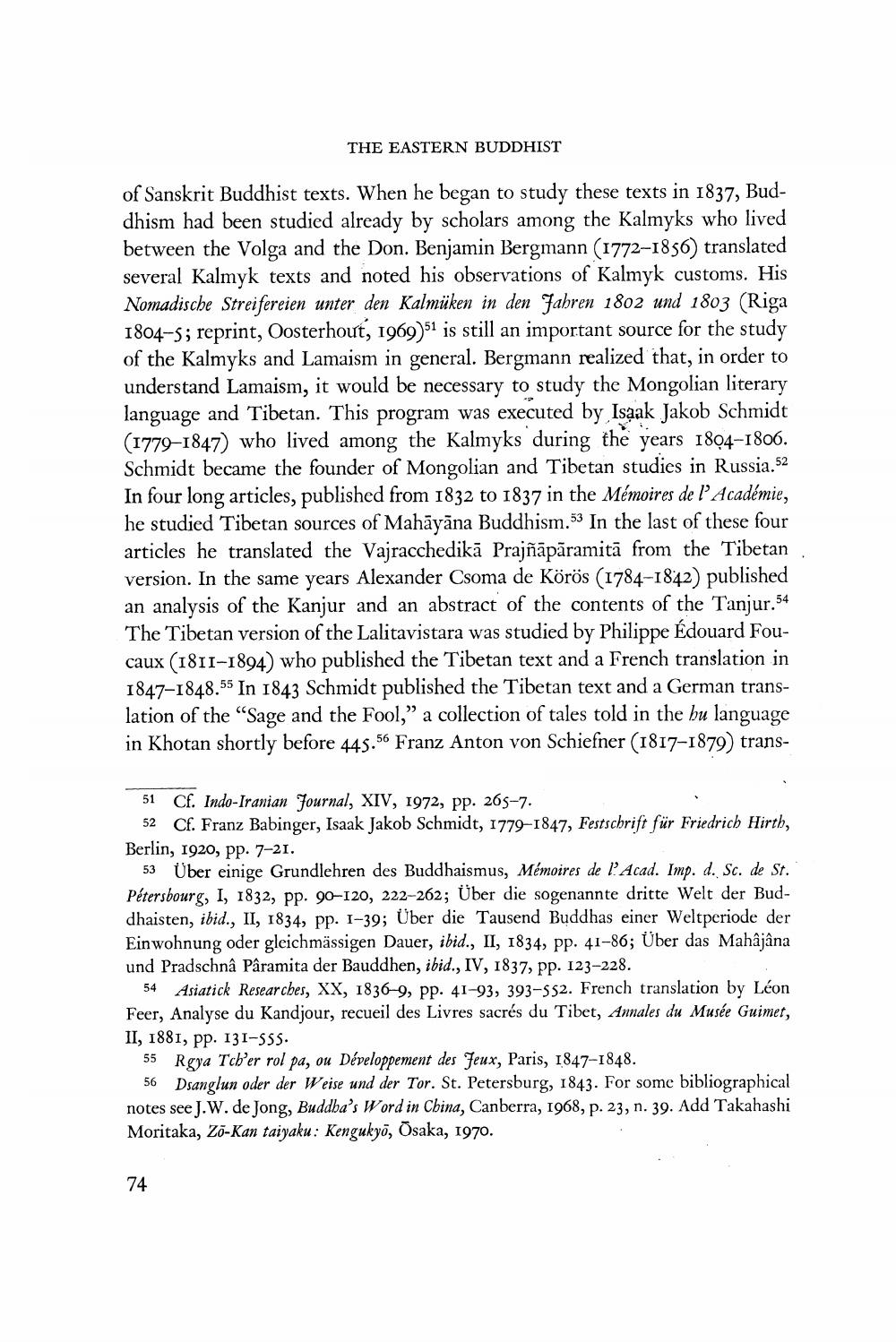________________
THE EASTERN BUDDHIST
of Sanskrit Buddhist texts. When he began to study these texts in 1837, Buddhism had been studied already by scholars among the Kalmyks who lived between the Volga and the Don. Benjamin Bergmann (1772-1856) translated several Kalmyk texts and noted his observations of Kalmyk customs. His Nomadische Streifereien unter den Kalmüken in den Jahren 1802 und 1803 (Riga 1804-5; reprint, Oosterhout, 1969)51 is still an important source for the study of the Kalmyks and Lamaism in general. Bergmann realized that, in order to understand Lamaism, it would be necessary to study the Mongolian literary language and Tibetan. This program was executed by Isaak Jakob Schmidt (1779-1847) who lived among the Kalmyks during the years 1804-1806. Schmidt became the founder of Mongolian and Tibetan studies in Russia.52 In four long articles, published from 1832 to 1837 in the Mémoires de l'Académie, he studied Tibetan sources of Mahayana Buddhism.53 In the last of these four articles he translated the Vajracchedikā Prajñāpāramitā from the Tibetan version. In the same years Alexander Csoma de Körös (1784-1842) published an analysis of the Kanjur and an abstract of the contents of the Tanjur.54 The Tibetan version of the Lalitavistara was studied by Philippe Édouard Foucaux (1811-1894) who published the Tibetan text and a French translation in 1847-1848.55 In 1843 Schmidt published the Tibetan text and a German translation of the "Sage and the Fool," a collection of tales told in the bu language in Khotan shortly before 445.56 Franz Anton von Schiefner (1817-1879) trans
51 Cf. Indo-Iranian Journal, XIV, 1972, pp. 265-7.
52 Cf. Franz Babinger, Isaak Jakob Schmidt, 1779-1847, Festschrift für Friedrich Hirth, Berlin, 1920, pp. 7-21.
53
Über einige Grundlehren des Buddhaismus, Mémoires de l'Acad. Imp. d. Sc. de St. Pétersbourg, I, 1832, pp. 90-120, 222-262; Über die sogenannte dritte Welt der Buddhaisten, ibid., II, 1834, pp. 1-39; Über die Tausend Buddhas einer Weltperiode der Einwohnung oder gleichmässigen Dauer, ibid., II, 1834, pp. 41-86; Über das Mahâjâna und Pradschnâ Pâramita der Bauddhen, ibid., IV, 1837, pp. 123-228.
54 Asiatick Researches, XX, 1836-9, pp. 41-93, 393-552. French translation by Léon Feer, Analyse du Kandjour, recueil des Livres sacrés du Tibet, Annales du Musée Guimet, II, 1881, pp. 131-555.
55 Rgya Tch'er rol pa, ou Développement des Jeux, Paris, 1847-1848.
56 Dsanglun oder der Weise und der Tor. St. Petersburg, 1843. For some bibliographical notes see J.W. de Jong, Buddha's Word in China, Canberra, 1968, p. 23, n. 39. Add Takahashi Moritaka, Zō-Kan taiyaku: Kengukyō, Ōsaka, 1970.
74




